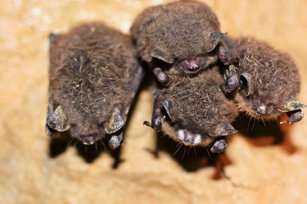White patches on these little brown bats are signs of white-nose syndrome. Credit: Michael Schirmacher, Bat Conservation International
Although white-nose syndrome (WNS) has pushed some bat populations to extinction, researchers have found that higher fat stores are helping some little brown bats to survive this deadly disease. The study, led by scientists at UC Santa Cruz, was published February 19 in the Journal of Animal Ecology.
WNS is a debilitating disease that has decimated bat populations throughout North America. The disease is caused by a fungal pathogen that infects the skin of hibernating bats, often appearing as white fuzzy patches on their noses and wings. Eventually, WNS causes bats to burn through stored fat reserves, resulting in death by starvation.
The paper's authors set out to learn more about why certain populations of little brown bats in the Northeastern United States are persisting while afflicted with WNS, even after initial population declines. First author Tina Cheng, now a postdoctoral researcher with Bat Conservation International (BCI), conducted the study as part of her thesis research at UC Santa Cruz, where she worked with coauthors Marm Kilpatrick and Winifred Frick, both faculty members in the Department of Ecology and Evolutionary Biology. Frick is also chief scientist at BCI.
The researchers wanted to determine if the persisting populations of bats were protected by increased fat stores in winter or if they were resistant to or escaping infection. The team collected data on disease status and fat stores from six remnant colonies of little brown bats, comparing data from 2009, when WNS first hit, to 2016, several years after these bat colonies started to show signs of stabilization.
"Understanding how bats are able to survive WNS is important for helping us to strategically help other affected bat colonies," said Cheng. "What's interesting about these surviving little brown bats is that they are using a physiological mechanism of building up higher winter fat stores that helps them tolerate this disease. It shows that these bats have a great deal of resilience, and that other affected colonies may also be able to survive if we can give them a helping hand."
The study suggests that helping bats to survive WNS may require a holistic approach. In lieu of extinguishing or reducing the fungal pathogen, people may be able to help bats improve their body condition in preparation for winter through actions such as protecting or restoring wetlands and other critical foraging habitats.
Little brown bats and other bat species play critical roles in our ecosystems as consumers of insects, including agricultural pests. Research on how bats respond to perturbations such as WNS informs ongoing efforts to protect these and other affected colonies.
More information: Tina L. Cheng et al. Higher fat stores contribute to persistence of little brown bat populations with white-nose syndrome, Journal of Animal Ecology (2019). DOI: 10.1111/1365-2656.12954
Journal information: Journal of Animal Ecology
Provided by University of California - Santa Cruz
























